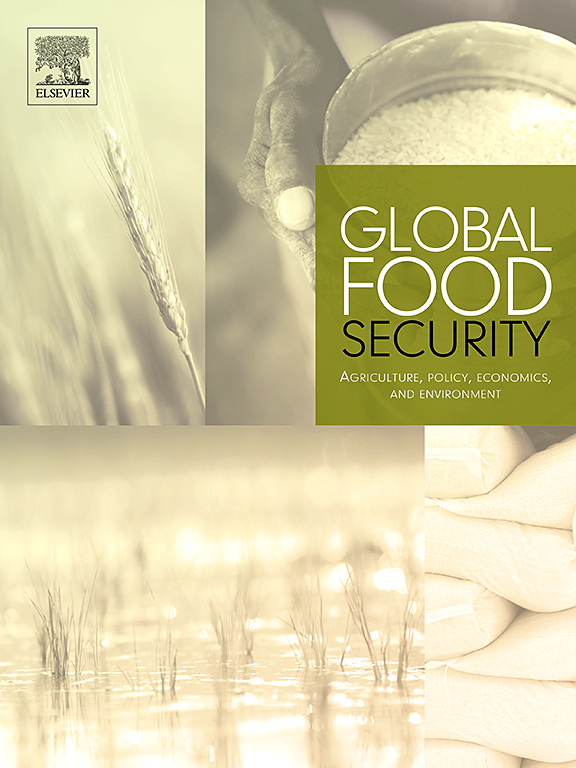营养单一栽培?美国的水果和蔬菜是在哪里生产的
IF 9.6
1区 经济学
Q1 FOOD SCIENCE & TECHNOLOGY
Global Food Security-Agriculture Policy Economics and Environment
Pub Date : 2025-04-15
DOI:10.1016/j.gfs.2025.100860
引用次数: 0
摘要
美国的农业食品系统主要面向为牲畜、生物燃料和其他引起人类和环境健康关注的高度加工副产品种植谷物。与此同时,美国处于贸易逆差状态,进口的水果和蔬菜是出口的三倍。那些在美国生产的水果和蔬菜依赖于不稳定的劳动力体系,对农民和农场工人的福利造成了不可持续的成本,在不断变化的贸易协定和移民政策中暴露了这些体系的断裂和不稳定性。为了克服这些裂痕,越来越迫切需要建立更多样化和更具抵御力的粮食系统。利用国家规模的农业和劳动力数据集,我们提出以下问题:1)当前美国农业景观在多大程度上生产出健康和多样化饮食所需的水果和蔬菜?2)这些景观有多多样?3)农民工如何支持果蔬生产和多样性?我们表明,美国农业景观不能生产健康和多样化饮食所需的水果和蔬菜。水果和蔬菜生产集中在该国的沿海地区,占用的土地很少,因此很难在全国范围内看到,跟踪和了解。此外,随着种植水果和蔬菜的农田比例的增加,水果和蔬菜的多样性减少,这表明大多数水果和蔬菜都是在简化的系统中种植的。最后,水果和蔬菜生产比例最高的县,H-2A农场工人证书的平均水平也最高,这表明随着水果和蔬菜生产的扩大,对外来劳动力的依赖不成比例。这项研究有助于理清我们在美国种植的东西和我们吃的东西之间的联系,缓和了在美国增加水果和蔬菜产量的呼声,但却没有调和这些现有系统积累的担忧。本文章由计算机程序翻译,如有差异,请以英文原文为准。
Nutritious monocultures? Where and how fruits and vegetables are produced in the US
The United States (US) agri-food system is primarily oriented toward growing grain for livestock, biofuels, and other highly processed byproducts that cause concern for human and environmental health. Simultaneously, the US is in a trade deficit, importing three times as many fruits and vegetables as it exports. Those fruits and vegetables that are produced in the US rely on precarious labor systems and unsustainable costs to the wellbeing of farmers and farmworkers, exposing the fractures and precarity of these systems amidst changing trade agreements and immigration policies. To overcome these fractures, calls for more diverse and resilient food systems are increasingly urgent. Using national-scale agricultural and labor datasets, we ask: 1) How well do current US agricultural landscapes produce the fruits and vegetables needed for a healthy and diverse diet at scale? 2) How diverse are these landscapes? 3) How does migrant labor support fruit and vegetable production and diversity? We show that US agricultural landscapes are not producing the fruits and vegetables needed for a healthy and diverse diet. Fruit and vegetable production is concentrated on the coasts of the country and occupies little land, making it difficult to see, track, and understand on a national scale. Further, as the proportion of cropland under fruit and vegetable production increases, fruit and vegetable diversity decreases, suggesting that most fruits and vegetables are grown in simplified systems. Finally, counties with the highest proportion of fruit and vegetable production have the highest averages of H-2A farmworker certifications, emphasizing a disproportionate reliance on migrant labor as fruit and vegetable production expands. This study helps to disentangle the link between what we grow and what we eat in the US, tempering calls to increase fruit and vegetable production in the US writ large without reconciling the accumulating concerns of these current systems.
求助全文
通过发布文献求助,成功后即可免费获取论文全文。
去求助
来源期刊

Global Food Security-Agriculture Policy Economics and Environment
FOOD SCIENCE & TECHNOLOGY-
CiteScore
20.90
自引率
3.40%
发文量
69
期刊介绍:
Global Food Security plays a vital role in addressing food security challenges from local to global levels. To secure food systems, it emphasizes multifaceted actions considering technological, biophysical, institutional, economic, social, and political factors. The goal is to foster food systems that meet nutritional needs, preserve the environment, support livelihoods, tackle climate change, and diminish inequalities. This journal serves as a platform for researchers, policymakers, and practitioners to access and engage with recent, diverse research and perspectives on achieving sustainable food security globally. It aspires to be an internationally recognized resource presenting cutting-edge insights in an accessible manner to a broad audience.
 求助内容:
求助内容: 应助结果提醒方式:
应助结果提醒方式:


